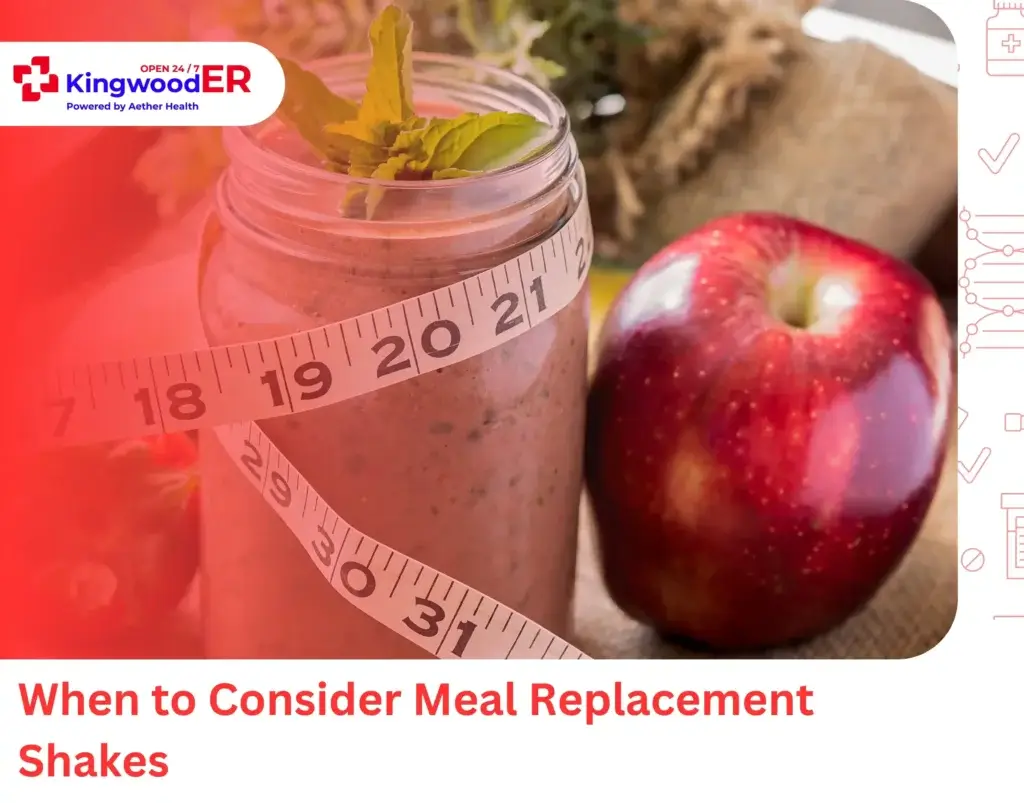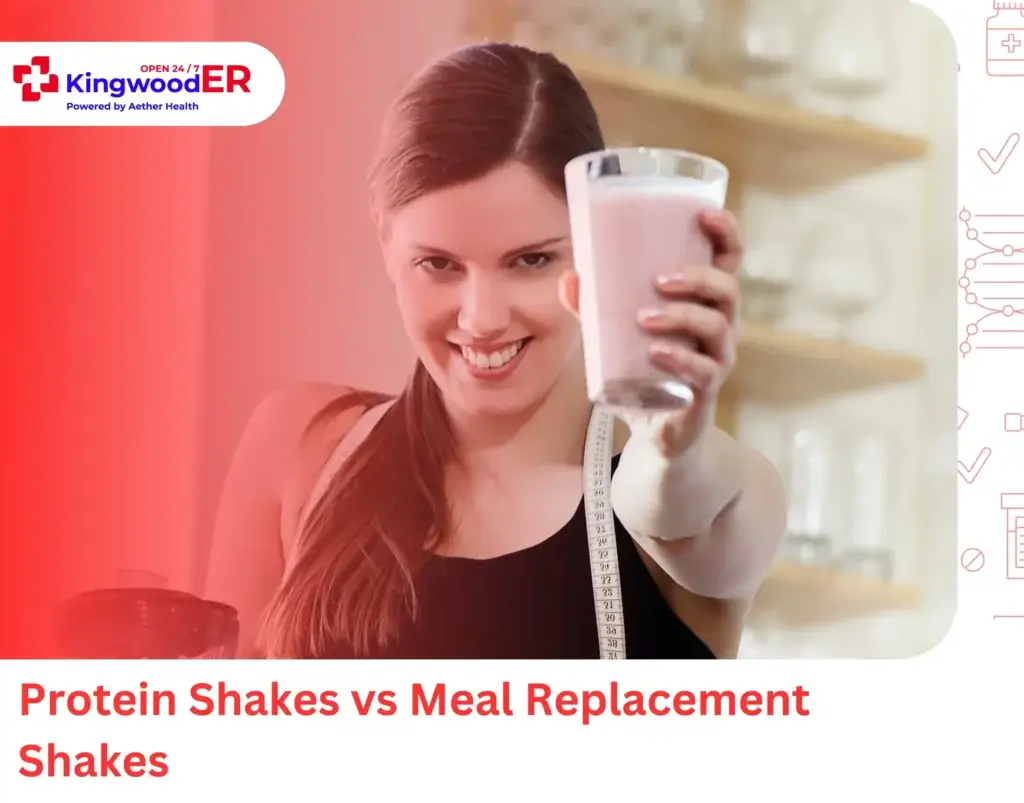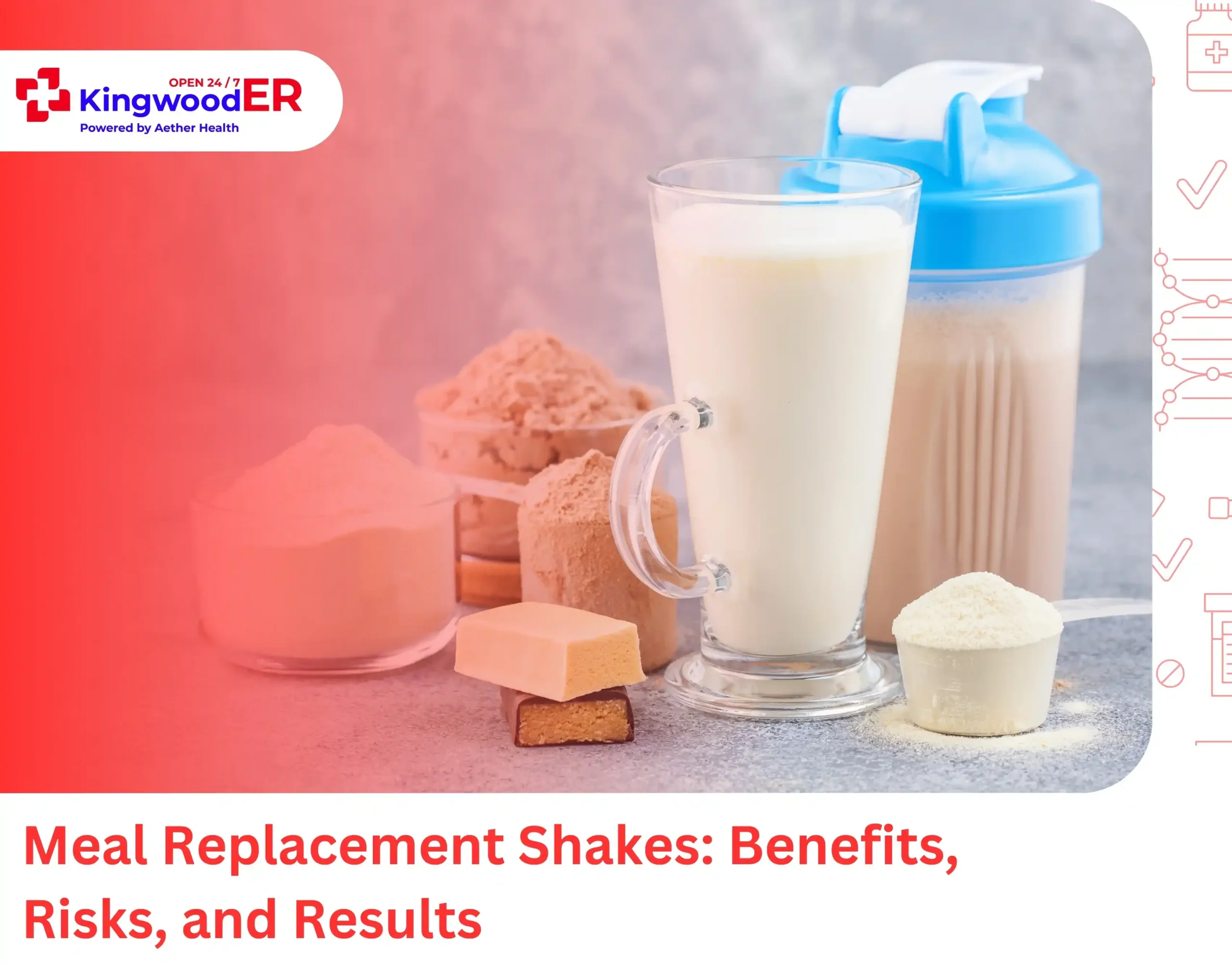Meal replacement shakes promise convenient nutrition, but nearly 70% of users don’t understand what these products actually contain. Many of these liquid formulas deliver excess sugar and insufficient protein instead of balanced meals.
Replacing meals without proper guidance risks vitamin deficiencies, muscle loss, and metabolic changes that can trigger serious health issues. Your body needs specific nutrients in balanced amounts that many popular shakes simply don’t provide.
At Kingwood ER, we see patients with nutrition-related issues daily. Whether you want weight management, quick meals during busy days, or recovery support, we help you select meal replacement drinks that truly benefit your health goals.
What Are Meal Replacement Shakes?

Meal replacement shakes are drinks formulated to substitute for a complete meal while providing essential nutrients. Unlike protein shakes that focus mainly on muscle building, meal replacement shakes aim to deliver balanced nutrition similar to what you’d get from food.
These products typically contain protein for muscle maintenance, carbohydrates for energy, healthy fats for hormone function, and vitamins and minerals for overall health. They come in ready-to-drink bottles, powders you mix with water or milk, and bars designed for on-the-go consumption.
What Is Included in a Meal Replacement Shake?
Quality meal replacement shake ingredients vary by brand but generally include:
Protein sources:
- Dairy-based: whey, casein
- Plant-based: soy, pea, brown rice, hemp
Carbohydrate base:
- Whole food sources: oats, quinoa, banana
- Added sugars: maltodextrin, fructose, cane sugar
Essential components:
- Dietary fiber for digestive health
- Essential fatty acids from flaxseed, MCT oil, or sunflower oil
- Vitamin and mineral blends to meet daily requirements
Many formulations also contain thickeners, sweeteners, and flavoring agents to improve taste and texture while maintaining nutritional value.
Benefits of Meal Replacement Shakes
Meal replacement shakes offer several advantages for various health needs and lifestyle situations:
1. Nutritional Convenience:
These shakes eliminate time spent on grocery shopping, cooking, and cleanup, while providing quick meal solutions for busy schedules. They offer healthier alternatives to fast food with controlled calorie content and create portable nutrition for travel or workplace consumption.
2. Weight Management Support:
Meal replacement drinks deliver precise calorie control (typically 150-400 calories per serving) and help create calorie deficits needed for sustainable weight loss. Their high protein content increases satiety, reduces hunger, and assists with portion control by eliminating guesswork in meal sizing.
3. Recovery Support:
Meal replacement shakes offer easily digestible nutrition for healing after illness or surgery when appetite is suppressed. They deliver protein needed for tissue repair without digestive strain, creating a nutrient-dense alternative when solid foods are challenging.
4. Dietary Restrictions Solutions:
For individuals managing gastrointestinal conditions like Irritable Bowel Syndrome (IBS) or Inflammatory Bowel Diseases (IBDs), meal replacement shakes can be a helpful alternative. They accommodate various food allergies and sensitivities and are a good option when you do not feel like eating solid foods.
The best meal replacement shakes combine these benefits with high-quality ingredients and a balanced nutritional profile that truly substitutes for whole food nutrition.
When to Consider Meal Replacement Shakes

Meal replacement shakes aren’t right for every situation, but they can be valuable nutrition tools in specific circumstances. Knowing when these products offer genuine benefits can help you use them effectively without creating nutritional gaps.
Meal Replacement Shakes for Weight Loss
Weight management is the most common reason people turn to meal substitute shakes. Research shows replacing 1-2 meals daily with quality shakes can create consistent calorie deficits that lead to sustainable weight loss. Look for options with:
- 20-30g protein to preserve muscle mass during weight loss
- Fiber content (minimum 3g) to maintain fullness
- Lower calorie counts (200-400 calories per serving)
- Low added sugar (under 10g per serving)
Many successful weight loss programs incorporate meal replacements as structured tools rather than random meal skipping, which often backfires by triggering excessive hunger.
Meal Replacement Shakes for Busy Professionals
When demanding schedules make proper meals impossible, quality meal replacements prevent the energy crashes that come from skipping meals. They provide better nutrition than typical grab-and-go options like fast food or vending machine snacks.
The best meal replacement options for busy lifestyles contain slow-digesting carbohydrates that provide sustained energy without blood sugar spikes. Many professionals keep shelf-stable options at work for unpredictable days when lunch breaks disappear.
Meal Replacement Shakes After Surgery or Illness
During recovery periods, your body needs extra nutrition despite potentially reduced appetite. Meal replacement drinks offer concentrated nutrition that’s:
- Easier to consume when solid food seems unappealing
- Gentler on the digestive system
- Nutrient-dense to support healing processes
Medical professionals often recommend specific formulations based on individual recovery needs, particularly for patients struggling to maintain adequate protein intake.
Meal Replacement Shakes for Seniors and Nutritional Support
Age-related appetite changes, medication effects, and physical limitations can make meal preparation challenging for seniors. Quality meal replacement shakes help:
- Prevent unintentional weight loss
- Provide essential nutrients that might otherwise be missed
- Offer easy nutrition that requires minimal preparation
Look for formulations specifically designed for older adults, which often contain higher calcium, vitamin D, and protein to support bone health and muscle maintenance.
Lack of Appetite:
If you’re experiencing a lack of appetite due to illness, medical treatments, or other underlying factors, meal replacement shakes can be a beneficial way to ensure you are still receiving necessary nutrition. When the thought of a full meal is unappealing or overwhelming, a shake can offer a less daunting and more easily digestible way to consume essential calories and nutrients.
Best Meal Replacement Shakes for Different Needs
Not all meal replacement formulations serve the same purpose. Different health goals require specific nutritional profiles to achieve optimal results. Let’s understand these differences so you can select products that align with your specific needs.
Weight Loss Shakes
The ideal weight loss meal replacement shake contains:
- Higher protein content (25-30g per serving) to preserve muscle mass
- Moderate carbohydrates (15-25g) with minimal added sugars
- Fiber (5-8g) to promote fullness and digestive health
- Lower calorie count (typically 200-300 calories per serving)
- Essential vitamins and minerals to prevent deficiencies during calorie restriction
Look for formulations with hunger-controlling ingredients like whey protein isolate, casein, or pea protein combined with soluble fibers. Avoid products with excessive sugar alcohols, which can cause digestive discomfort.
Meal Replacement Shakes for Weight Gain and Muscle Gain
For muscle building and recovery, prioritize formulations with:
- Higher protein content (30g+ per serving) with complete amino acid profiles
- More calories (400-600 per serving) to support growth
- Quality carbohydrates (40-60g) to replenish glycogen
- Essential fats including omega-3s to support hormone production
- Added nutrients like zinc, magnesium and vitamin D that support muscle function
The best options contain multiple protein sources with varying digestion rates (whey, casein, egg) and complex carbohydrates rather than simple sugars. Some include creatine, BCAAs, or glutamine for additional recovery support.
Vegan Meal Replacement Shakes
Effective plant-based meal replacements require careful formulation:
- Protein blends (pea, brown rice, pumpkin seed) to create complete amino acid profiles
- Vitamin B12, iron, zinc, and calcium to address common plant-diet deficiencies
- Omega-3 fatty acids from algae or flaxseed oil
- Natural sweeteners like stevia or monk fruit instead of artificial options
The best vegan meal replacement shakes combine multiple protein sources to overcome the limiting amino acids in any single plant protein. The best options are fortified with nutrients commonly lacking in plant-based diets.
Diabetic Shakes
For blood sugar management, look for:
- Low glycemic carbohydrates (under 20g net carbs)
- Higher fiber content (minimum 5g) to slow glucose absorption
- Moderate protein levels (20-25g) without excessive amounts
- No added sugars or artificial sweeteners that may affect insulin response
- Added chromium and magnesium that support glucose metabolism
The ideal diabetic-friendly formulation uses complex carbohydrates from sources like oats or quinoa rather than maltodextrin or corn syrup. Many contain small amounts of healthy fats to further slow nutrient absorption and prevent blood sugar spikes.
Meal Replacement Shakes for Seniors
Older adults face unique nutritional challenges that specialized meal replacements for elderly can address. Seniors often benefit from formulations that provide:
- Higher protein content to combat age-related muscle loss
- Added calcium and vitamin D for bone maintenance
- Calorie-dense nutrition for those with reduced appetites
- Easy digestibility without excessive fiber that might reduce nutrient absorption
- Complete, ready-to-drink options that require no preparation
Many geriatric specialists recommend meal replacements as supplements rather than replacements for seniors. They focus on boosting overall nutrition between meals rather than substituting whole foods entirely.
How to Choose a Meal Replacement Shake

Selecting the right meal replacement shake requires careful evaluation of both ingredients and nutritional profile. Many products marketed as “meal replacements” are actually protein supplements with minimal additional nutrition. True meal replacements should provide balanced macronutrients, vitamins, and minerals similar to what you’d find in a healthy meal.
Start by checking that the product explicitly states it’s a meal replacement, not just a protein supplement. Then evaluate the nutrition facts panel against your specific health goals and dietary requirements.
Reading Meal Replacement Shake Labels
Understanding how to interpret nutrition facts labels enables you to make informed choices:
- Check serving size first – some products list impressive nutrition but require multiple scoops
- Look at the ingredient list order – ingredients appear by weight from highest to lowest
- Compare the protein-to-carb ratio – this varies significantly between brands
- Evaluate percentage of Daily Values for vitamins and minerals
- Identify protein sources to determine complete vs. incomplete amino acid profiles
Many manufacturers use varied terminology to describe similar ingredients. For example, “glucose syrup” and “corn syrup” are essentially the same thing. Learning to decode these terms helps you identify hidden sugars and fillers.
Important Nutritional Elements
When comparing meal replacement shake ingredients, prioritize these key components:
- Protein Content: Look for 15-20g of high-quality protein per serving. Protein is essential for promoting satiety, maintaining muscle mass, and supporting overall metabolic health.
- Fiber Profile: Choose products with 3-7g of fiber per serving. Fiber is important for maintaining good gut health and helps to increase feelings of fullness, which can be beneficial for weight management.
- Vitamin and Mineral Content: Verify the shake contains at least 25% of daily values for essential micronutrients.
- Sugar and Sweeteners: The best formulations contain under 10g of added sugar per serving.
- Healthy Fats: Quality meal replacements include beneficial fats from sources like flaxseed or MCT oil. Health authorities like WHO and FAO recommend limiting fat content to no more than 30% of total calories in meal replacements.
- Calorie Range: Consider your daily calorie needs when choosing a meal replacement shake. Most effective meal replacements contain 200-400 calories per serving, depending on your goals.
Ingredients to Avoid in Meal Replacement Shakes
Many popular meal replacement products contain problematic ingredients that can undermine health goals. Look for:
- Excessive Added Sugars: Some products contain 20+ grams of added sugar, equivalent to dessert.
- Artificial Sweeteners: Ingredients like aspartame and sucralose may disrupt gut bacteria and trigger cravings.
- Hydrogenated Oils: These trans fats increase inflammation and heart disease risk.
- Artificial Colors: Synthetic dyes like Red 40 and Yellow 5 have been linked to behavioral issues and hypersensitivity.
- Excessive Preservatives: BHA, BHT and similar chemicals may disrupt hormone function.
Avoid products with extensive chemical ingredient lists and unrecognizable components. Quality meal replacements typically have shorter, cleaner ingredient lists with recognizable food components.
Types of Meal Replacement Shakes
Meal replacement shakes come in various forms and cater to different needs. Some common types include:
- Ready-to-drink shakes: These are pre-mixed and convenient for immediate consumption. They work perfectly for travel, office settings, or emergency nutrition. Most require no refrigeration until opened but typically cost more per serving than alternatives.
- Powdered shakes: These require mixing with water, milk, or other liquids and offer flexibility in portion size and ingredients. Many users enhance nutrition by adding fruits, nut butters, or greens during blending.
- Plant-based shakes: Formulated with protein sources like pea, soy, or brown rice, these are suitable for vegans and those with dairy sensitivities.
- Organic shakes: Made with organic ingredients to appeal to those seeking natural and less processed options. These options appeal to health-conscious consumers concerned about chemical exposure but may require refrigeration after mixing due to fewer preservatives.
Homemade Meal Replacement Shakes
Commercial meal replacement drinks aren’t your only option. You can create your own nutritionally balanced drinks with fresh ingredients. Start with a protein base like Greek yogurt, cottage cheese or protein powder. Add healthy fats from nut butter or avocado, then mix in oats or sweet potato for sustained energy.
Don’t forget to add fresh or frozen fruits for flavor and nutrients. A handful of spinach can provide useful vitamins without changing taste. For thickness and extra fiber, try chia seeds or ground flax.
While homemade versions taste fresher and cost less, they lack precise vitamin formulations of commercial products. Consider a basic multivitamin if using homemade meal replacement shakes regularly in place of meals.
Protein Shakes vs Meal Replacement Shakes

Many consumers confuse these two distinct supplement categories, but they serve very different nutritional purposes:
Protein Shakes:
- Primarily deliver protein (20-30g) with minimal other nutrients
- Typically contain 100-150 calories per serving
- Offer limited vitamins and minerals
- Focus on muscle recovery and building
- Usually contain 0-3g of carbohydrates and minimal fat
- Best used: post-workout, between meals, or as protein supplementation
Meal Replacement Shakes:
- Provide balanced macronutrients (protein, carbs, fats)
- Typically contain 200-400 calories per serving
- Include significant vitamin and mineral content
- Focus on total nutrition similar to a small meal
- Usually contain 15-40g of carbohydrates and moderate fat
- Best used: to replace actual meals when necessary
The key distinction: protein shakes supplement protein intake while meal replacements attempt to substitute for complete meals. Using protein shakes as meal replacements can create significant nutritional gaps over time.
Digestive Issues from Meal Replacement Shakes: Causes and Solutions
Many users experience stomach pain after protein shakes or meal replacements, particularly when first introducing them to their diet. These meal replacement shake side effects typically have identifiable causes and solutions:
- Ingredient Sensitivity: Whey and casein proteins can trigger discomfort in people with undiagnosed dairy sensitivities. Plant proteins like pea or soy may cause similar reactions in sensitive individuals. Try switching protein sources if you experience consistent digestive distress.
- Consumption Speed: Drinking shakes too quickly overloads your digestive system with concentrated nutrition. Sip slowly over 10-15 minutes to allow proper enzyme production and reduce stomach discomfort after shakes.
- Fiber Content: Many formulations contain added fibers that can cause gas and bloating when introduced suddenly. Start with half-servings and gradually increase to full portions as your digestive system adapts.
- Sugar Alcohols: Ingredients like sorbitol and maltitol (common in low-sugar formulas) frequently cause digestive issues from meal replacement shakes. Look for formulations without these sweeteners if you experience persistent problems.
- Dilution Ratio: Using less liquid than recommended creates an overly concentrated mixture that can overwhelm digestion. Always follow mixing instructions carefully and consider adding extra water if discomfort occurs.
Most digestive issues resolve as your body adjusts to the formula, typically within 1-2 weeks. If problems persist, consult a healthcare provider to rule out underlying digestive conditions that might require a specialized formula.
Making Meal Replacements Work for Your Health Goals
Meal replacement shakes fill specific nutrition gaps but don’t replace the benefits of whole foods long-term. Quality products with balanced proteins, fibers, and essential nutrients can support weight management, busy schedules, or recovery periods when chosen wisely.
Your body responds uniquely to different formulations. What works for a colleague might cause digestive issues for you. Start with small portions, evaluate your response, and adjust accordingly.
At ER of Kingwood, we see both the benefits and pitfalls of nutrition shortcuts. For personalized guidance, especially if you manage existing health conditions, consult a registered dietitian before making meal replacements a regular part of your routine.
FAQs
1. Are meal replacement shakes for weight loss any good?
Yes. Research backs meal replacements for modest weight loss when replacing 1-2 meals daily. Look for products with ample protein and fiber, not just low calories. They work best as part of a structured plan, not random meal skipping.
2. Can you drink meal replacement shakes every day?
Yes, but only for 1-2 meals daily. Your body needs whole foods too. Exclusive shake diets lack diverse nutrients and can weaken your digestive system over time. Mix up your options if using them regularly.
3. What are the side effects of meal replacement shakes?
Digestive upset (gas, bloating), hunger between meals, and possible headaches when starting out. Exclusive use can create nutrient gaps. Some people struggle to return to normal eating after extended use.
4. Can meal replacement shakes cause stomach pain?
Yes. Common culprits include dairy proteins, high fiber content, artificial sweeteners, and drinking too fast. Start with smaller amounts, mix properly, and choose products without your trigger ingredients.




